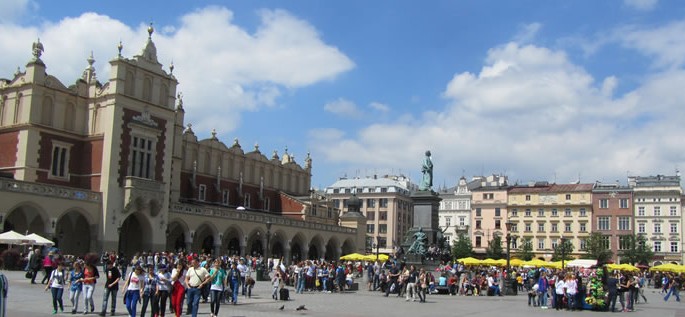Esperanto

Esperanto, Eo, La Lingvo Internacia, is the most widely spoken constructed (or artificial) international language. A constructed language is one whose phonology, grammar and vocabulary are artificially designed rather than having evolved naturally over time. Constructed languages tend to be very regular because they did not undergo historical changes that normally occur in natural languages.
The name Esperanto derives from Doktoro Esperanto, the pseudonym of a Polish linguist, Dr. Ludovic Lazarus Zamenhof who created Esperanto in the late 1870s and early 1880s. His goal was to devise a universal second language that would help combat nationalism and promote internationalism. The first Esperanto grammar was published in 1887 in Warsaw, Poland. The first world congress of Esperanto speakers was held in France in 1905. Since then well-attended world congresses have been held every year, interrupted only by the two World Wars.
The phonology, grammar, and vocabulary of Esperanto are based on Indo-European languages. In a way, Esperanto is not a truly an international language, but more like an Indo-European language with no national affiliation. Speakers of non-Indo-European languages will probably find Esperanto as easy or difficult to learn as any naturally evolved Romance language.
Esperanto has been in continuous use since its creation, even though it is not recognized as an official language by any country. According to Ethnologue, Esperanto is spoken by some 2 million people as a second language in 115 countries, most of them in Central and Eastern Europe, East Asia, and South America.
There are over 25,000 original and translated books in Esperanto and over a hundred Esperanto magazines. Many Esperanto speakers use the language for travel throughout the world using the Pasporta Servo, a hospitality service for speakers of Esperanto. Others have pen pals in many countries around the world using services such as Esperanto Mondo. Every year, several thousand Esperanto speakers meet to attend the World Congress of Esperanto (Universala Kongreso de Esperanto).
Dialects
Esperanto does not have dialectal variation.
Structure
Since Esperanto is spoken only as a second language, its pronunciation varies somewhat depending on the first language of its speakers.
Vowels
Like many European languages, Esperanto has five vowels.
|
Front
|
Central
|
Back
|
|
|---|---|---|---|
| Close |
i
|
u
|
|
| Mid |
e
|
. |
o
|
| Open |
a
|
Consonants
Esperanto has the following consonants, all of which are typical of European languages. It allows up to three-consonant clusters in initial position, e.g., stranga ‘strange’.
|
Bilabial
|
Labiodental
|
Alveolar
|
Postalveolar
|
Palatal
|
Velar
|
Glottal
|
||
| Stops | voiceless |
p
|
t
|
k
|
||||
| voiced |
b
|
d
|
g
|
|||||
| Fricatives | voiceless |
f
|
s
|
ʃ
|
x
|
h
|
||
| voiced |
v
|
z
|
ʒ
|
|||||
| Affricates | voiceless |
ts
|
tʃ
|
|||||
| voiced |
dʒ
|
|||||||
| Nasals |
m
|
n
|
||||||
| Lateral approximant |
l
|
|||||||
| Trill or flap |
r
|
|||||||
| Approximant |
j
|
- /ʃ/ = sh in shop
- /ʒ/ =- s in measure
- /tʃ/ = ch in chop
- /dʒ/ = j in job
- /x/ has no equivalent in English
- /j/ = y in yet
Stress
Stress always falls on the next-to-last (penultimate) syllable, just like in Polish, Zamenhof’s native language.
Esperanto grammar is thoroughly European in that it is an inflective language, i.e., one in which words are formed by adding prefixes and suffixes to roots to mark grammatical functions.
Nouns, adjectives, and pronouns
- All nouns end in -o.
- All adjectives end in -a.
- Nouns and adjectives have two cases: nominative and accusative. The accusative is formed by adding -n to the nominative.
- Demonstrative and personal pronouns also have a genitive case.
- All other relationships are expressed by prepositions. All prepositions take the nominative case, e.g., de mia patrino ‘my mother’s’.
- There are two numbers: singular and plural. The plural is formed by adding -j to the singular.
- Adjectives generally agree with nouns in case and number.
- There is a single definite article la which is similar to the English definite article ‘the’. It always has the same form.
Verbs
- All verbs are regular.
- Verbs are not marked for person or number.
-
Verbs have the following endings:
IndicativePresent -asPast -isFuture -osConditional-usImperative-uInfinitive-I
- The passive is expressed by the appropriate form of esti ‘to be’ + past passive participle of the verb.
- Esperanto has a conditional and a jussive moods.
- Aspect in Esperanto bears some resemblance to Slavic lexical aspect (Aktionsart).
- Compound tenses are formed with the adjectival participles plus esti ‘to be’. The participle carries aspect and voice, while the verb carries the tense.
Word order
The word order of Esperanto is typically Subject – Verb – Object. Adjectives can either precede or follow nouns.
The vocabulary of Esperanto comes mainly from Latin by way of Greek, as well as Romance and Germanic languages. As a result, most of its words look familiar to speakers of Western European languages or to anyone who knows a Romance language.
| Hello | Saluton |
| Good morning | Bonan matenon |
| Goodbye | Ĝis poste, Ĝis (la) revido, Ĝis la, Ĝis, Adiaŭ |
| How are you? | Kiel vi fartas? |
| Thank you | Dankon |
| Please | Bonvolu |
| Excuse me | Pardonu! |
| Yes | Jes |
| No | Ne |
| Man | Homo, viro |
| Woman | Virino |
Below are Esperanto numerals 1-10.
|
1
|
2
|
3
|
4
|
5
|
6
|
7
|
8
|
9
|
10
|
|---|---|---|---|---|---|---|---|---|---|
|
unu
|
do
|
tri
|
kvar
|
kvin
|
ses
|
sep
|
ok
|
nau
|
dek
|
Writing
The Esperanto alphabet has 28 letters. 22 of them are the same as in English. There are no letters Q, W, X, and Y. There are six letters that do not exist in English: Ĉ, Ĝ, Ĥ, Ĵ, Ŝ, Ŭ.
|
A a
|
B b
|
C c
|
Ĉ ĉ
|
D d
|
E e
|
F f
|
G g
|
Ĝ ĝ
|
H h
|
Ĥ ĥ
|
I i
|
J j
|
Ĵ ĵ
|
|
K k
|
L l
|
M m
|
N n
|
O o
|
P p
|
R r
|
S s
|
Ŝ ŝ
|
T t
|
U u
|
Ŭ ŭ
|
V v
|
Z z
|
- c = ts
- ĉ = ch in chop
- ĝ = j in job
- ĥ = /x/ which has no equivalent in English
- ĵ = s in measure
- ŝ = sh in shop
- ŭ = w in cow
|
Universala Deklaracio de Homaj Rajtoj Artikolo 1 Ĉiuj homoj estas denaske liberaj kaj egalaj laû digno kaj rajtoj. Ili posedas racion kaj konsciencon, kaj devus konduti unu al alia en spirito de frateco. |
|
Universal Declaration of Human Rights Article 1 All human beings are born free and equal in dignity and rights. They are endowed with reason and conscience and should act towards one another in a spirit of brotherhood. |







